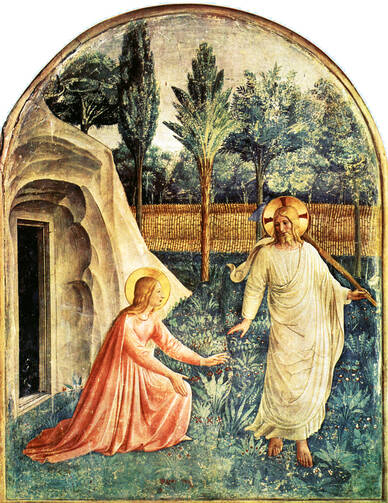Even nowadays—or should I say especially nowadays?—the sight of two people very much in love still delights us. The world continues to love and make excuses for lovers. A truly great love story will fill the cinemas and top the list of best-sellers. Yet the modern world has come to believe that love is blind. In their delirious joy lovers are supposed to be incapable of seeing how things really are.
Not everyone, however, has accepted our modern prejudice. “Give me a lover,” St. Augustine exclaimed, “and he will understand.” Augustine realized that it may take deep love to open our eyes and let us see the truth. The heart does have its reasons. Love helps us to know and share in reality.
In two episodes (Jn. 20:2-10; 21:1-14) the beloved disciple is mysteriously led by love to encounter Jesus truly risen from the dead. He enters the empty tomb, sees the grave cloths and believes (20:8). Love makes the beloved disciple jump at once to the right conclusion: Jesus has risen and is alive.
In the second scene the beloved disciple is one of seven disciples who have spent a night out fishing in Lake Tiberias. At dawn they all look across the waters towards the stranger who calls to them from the beach. But love allows the beloved disciple to identify who it is that has come to meet them at daybreak. “It is the Lord” (21:7). Once again love brings him to know the truth and recognize the risen Jesus.
The beloved disciple sees an empty tomb and reaches out in faith to the risen Lord. He hears a voice at dawn across the waters of a lake and knows himself to be in Jesus’ presence. Our lives are full of sights and sounds. Love can turn those sights and sounds into moments when we cry out: “It is the Lord.”
“Jesus, give us a heart to love you with. Then we shall truly see you, encounter you constantly, and recklessly believe in you.”
Likewise, Mary Magdalene meets the living Jesus because she has come back to the tomb looking for His dead body. The tears flood down her face (20:11,13,15). She now finds two angels sitting in the tomb like a guard of honor. She does not ask them for any help or information, but simply explains why she is weeping and turns her back on them. In her grief and love she is anxious only to locate the corpse of Jesus which “they” have taken away and laid somewhere.
Then Mary sees the “gardener” standing there in the garden outside the new tomb where Jesus had been buried (19:41). It is the risen Jesus, the new Adam who is inaugurating His new creation. Artists like Fra Angélico and Rembrandt have sensed something about the encounter that theologians have missed: its joyful playfulness. They depict Jesus as wearing a gardener’s hat or with a tool slung over his shoulder. His disguise delays briefly the moment of recognition.
Mary imagines that the “gardener” might have carried off the body, but expects that all the same he would be ready to help her: “Sir, if you have carried Him away, tell me where you have laid Him, and I will take Him away.” Then with one word Jesus changes her life. He calls her by name, “Mary.”
John’s Gospel has made much of Mary’s grief over the disappearance of Jesus’ corpse. She has been weeping outside the tomb; she has been weeping as she stooped to look into the tomb. The two angels and then the risen Jesus Himself have asked the reason for her tears. Now she knows Him to be gloriously alive. But apart from telling us that she clings to Jesus, the Gospel makes no attempt to capture her joy in a net of words. It is the same with the raising of Lazarus. John notes the tears and grief of Martha, Mary and Jesus Himself over the death of Lazarus (11:19,31), but discreetly declines to portray their happiness over his return to life.
In the Fourth Gospel no other encounter with Jesus matches the contrast between Mary Magdalene’s expectations and the outcome. She expects at most to be helped to find a missing corpse. Instead she learns that death has no final power over Jesus, and that she is to bring to the disciples the ultimate good news: “I have seen the Lord.”








